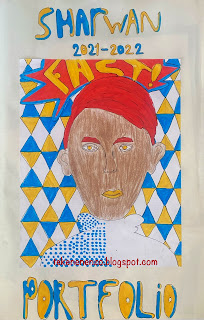Dutch tulips in the style of Romero Britto, by Malou, grade 6
This was one of my most successful lessons so far; students enjoyed it and the results were amazing. But hello copycats: Britto never painted tulips! So please don't copy this lesson (I saw a lot of them already on artblogs Pinterest), but create one yourself. Or at least: mention your source, kidsartists.blogspot.com!
You need:
- white drawing sheet A4 size
- permanent marker
- colour markers
- ruler
Romero Britto is a Brazilian artist. He was born in 1963 in grew up an extremely modest lifestyle amongst eight brothers and sisters in Recife Brazil. His drew and painted on any scrap of newspaper or cardboard he could find and filled them with colourful images of a beautiful world.
In 1983 Britto travelled to Europe to study the old masters. After this trip, he traveled to the USA where Pop Art was flourishing. He opened a gallery in Miami. In 1989,Absolut Vodka selected Britto to design an artwork with their famous logo. From that moment the name Britto was known to a greater public. His artwork are now represented in galleries and museums across five continents.
Paris in the style of Britto, by Emmy grade 6
Look at artwork of Britto on his
gallery. Discuss the salient features: bright colours,
simple shapes, the work is divided into sections that are filled with patterns, thick black outlines. Discuss how you to see
the difference between the drawn picture and the
background. Ask about the stylistic characteristics and where to classify this artist (Pop Art, Cubism).
The students have to make a drawing with a topic of their choice. No details, but only the main lines. Divide the drawing surface with pencil and ruler in several sections
. Trace all lines with a waterproof black marker and then colour them with markers in the way Britto did.
For the background we stamped circles with toilet rolls on a coloured sheet and pasted the artwork on it.
Flowers in the styleo of Britto, by Nadia grade 6


















































